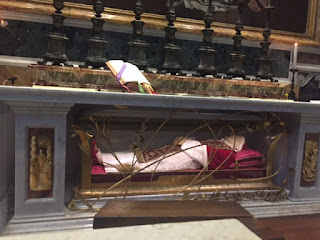July 4th
-- Happy Independence Day!
We headed
out of the city to San Lorenzo (Saint Lawrence of the Gridiron) who was martyred by being burned on a gridiron and were
greeted by a monument to Pope Pius XII, who visited and prayed with his people
of San Lorenzo within 24 hours after it
was bombed during World War II. He was
deeply moved by their loss of lives. Unfortunately, a lady of the parish was
being remembered at her funeral and we couldn’t get into the Church. We
wandered around the porch and noticed a raised tomb to an Italian politician
Alcide De Gaspari. His cause for canonization has been opened. This gives us hope for our politicians.
We moved
onto our next holy spot . . . Santa Croce in Gerusalemme (or The Church of the Holy Cross). In
this basilica are a variety of relics, mostly related to Our Lord’s Passion. Displayed were one of the nails that pierced
His Hands, two of the thorns from His Crown,
a section of the wood of the Cross and most of the title above His Head.
We spent time in quiet reflection before these vivid reminders of His Love for
each one of us. Included in this Church are also the remains of two women whose
lives ended in dedication to that same Lord, namely, St Helena (Mother of the
Emperor Constantine), who brought the relics from the Holy Land, and the remains of a modern saint, Antonietta Meo (1930-37), nicknamed Nennolina. This
young girl died at the age of six, after having suffering from bone cancer that
led to her left leg being amputated. She had visions, wrote letters (most
dictated to her mother) and composed a short prayer to Jesus, dedicating her
sufferings to him. At least one healing has been attributed to her intercession
since her death, and she is currently being considered for official
canonization as a saint. She had been baptized at Santa Croce and her body was
moved inside its walls in 1999. (SacredDestinations.com)
After lunch four of our pilgrims decided to go back to San
Lorenzo. After all our practice we were able to catch the bus that led us back.
As we approached the locked gates of the basilica and prayed to St Lawrence and
Blessed Pius IX, the little old
sacristan wandered out and opened the doors. We had the whole Church to ourselves
for about fifteen minutes-down the steps straight to the altar behind which St
Lawrence and St Stephen were buried. The sacristan even put on the lights for
us. We knelt to pray, asking these saints blessing on so many, then we went
behind the tomb to see the slab of marble Lawrence’s body was placed on after
his execution. It remains stained with his blood to this day. Immediately
behind the altar of Lawrence and Stephen
is the chapel where Blessed Pius IX or Pio Nono is laid out in splendor.
Although his original burial was done in secret due to his difficulties with
the Italian government, after his beatification, his new resting place is grande! In a glass coffin, with a silver
mask on his face and surrounded by golden mosaics lies a pope whose name we
have seen repeatedly at all the major shrines we have visited. Second only to
St Peter in length of time as pope, he supported and funded many projects and artistic
works. He is also remembered for the declaration of the Immaculate Conception,
the convocation of Vatican I, Papal Infallibility, and much more. (Church History
101).
The bus ride back to the Domus brought us to St John the
Lateran and the Holy Steps. There was just enough time to slowly climb the
steps on our knees, while reflecting on the Passion. These steps, brought by St
Helena back from Jerusalem are traditionally associated with the path Our Lord
trod during the night of His Passion. Now covered with walnut wood, centuries
of pilgrims have made the climb as part of their Holy Year pilgrimage.
Did you notice that this is written on the Fourth of July?
Our sisters at the Domus prepared a lovely celebration for us-complete with red
white and blue tablecloth and candles! Delicious hot dogs and hamburgers,
watermelon and homemade ice cream sandwiches-yum yum! We sang ‘God bless America’
at the beginning of the meal.
The porch of the Basilica of St. Lawrence
St. Helena, who brought the relics of the True Cross from Jerusalem to Rome
The ceiling in St. Helena's Chapel, at Santa Croce
Sisters venerating the tomb of Sts. Lawrence & Stephen
The blood-stained marble slab on which St. Lawrence's body was laid
The mortal remains of Blessed Pope Pius IX
Pilgrims at the Holy Stairs
The dinner table, as prepared for July 4th
Homemade ice cream sandwich












































